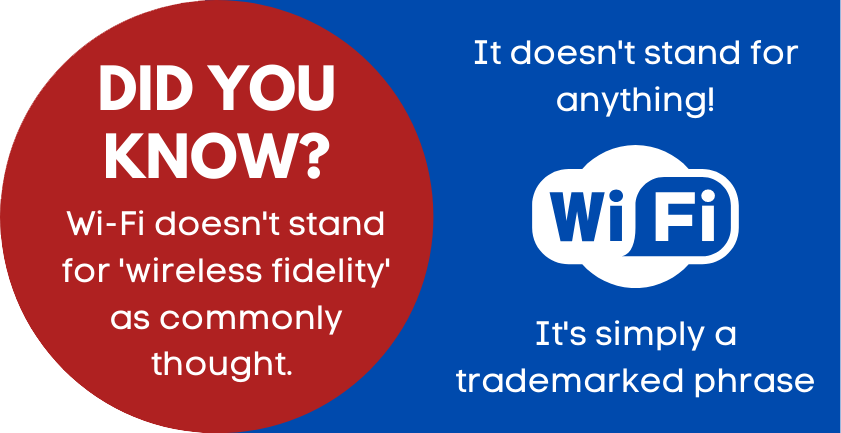You use it every day, but do you know how it works and that there were different variants of Wi-Fi? In today’s blog we’re going to look at how Wi-Fi works, and some of our top troubleshooting tips.
What is Wi-Fi?
- Wi-Fi is a wireless networking technology that uses radio waves to provide connectivity (internet) between devices.
- The networking standard for Wi-Fi is 802.11 and is governed by the Wi-Fi Alliance. Having a network standard means you can be sure that when you buy a device it will work with your Wi-Fi – no matter who the manufacturer is.

So, how does Wi-Fi Work?
- For Wi-Fi to work, you need two key components: an access point (like the phone socket in your wall at home) and a wireless interface for the client device (your router).
- Your internet service provider (ISP), such as Sky or BT, provides internet to the access point which is then broadcasted as a radio frequency by your router. Your device can then receive this and connect to the internet!
What about those different Wi-Fi variants you mentioned?
- There are several versions of the 802.11 standards but they all vary based on 2 main things: the bandwidth and the transfer speed.
- Bandwidth is the maximum amount of data that can be transferred at a time, whilst transfer speed is the speed at which this data can be moved. With both of these together you get the maximum data rate.
- Below is a graph showing the main variants of the 802.11 standard:
|
Standard |
Frequency band |
Max data rate |
|
802.11 |
2.4Ghz |
2Mbps |
|
802.11b |
2.4Ghz |
11Mbps |
|
802.11a |
5.0GGhz |
54Mbps |
|
802.11g |
2.4Ghz |
54Mbps |
|
802.11n |
2.4Ghz 5.0Ghz |
300 or 600Mbps |
|
802.11ac |
5.0Ghz |
6.93Gbps |
- As we get lower down the list we get the newest variants of Wi-Fi, which are able to transfer a huge amount of data very quickly.
What’s the difference between 2.4Ghz and 5Ghz?
- Ghz (or gigahertz) is the frequency of the radio signal your router creates. The higher the frequency the higher the transfer speed, but also it has a lower reach as higher frequency waves dissipate quicker.
- 5Ghz is a higher frequency so it will have a faster transfer speed, but won’t be good if you want to cover a large space due to its short range.
- 2.4Ghz has a slower transfer speed but is the best option when it comes to covering a big area.
- Most internet routers are dual-band which means both can be used depending on which is most needed at the time.

How can I make my Wi-Fi signal better?
- Try to position your router in the centre of the area you want to be covered.
- Avoid putting your router inside of a cupboard or anything that causes obstruction.
- Keep your router away from other objects that could cause interference – cordless phones, microwaves & baby monitors.
- If you are struggling with wireless signal in one room, consider how many walls or floors the signal is passing through and see if you could reduce this somehow.
- Use a Wi-Fi Boosters
- I’ve seen limited success with these, for some people they work well, for others not so well. The idea is it works like a signal repeater – you put it on the edge of your wireless network and the device will amplify the signal. The problem here is that it’s amplifying an already degraded signal and can sometimes cause more hassle than they’re worth.
- The ultimate solution is to have multiple access points that broadcast your wireless network. These can be set up by a professional and can really boost the connectivity of your house/workplace.
Still having Wi-Fi issues? Or want to talk about getting additional access points for your workplace or home? Give us a call on 01553 692727 or email us at [email protected] to see how we can help!
